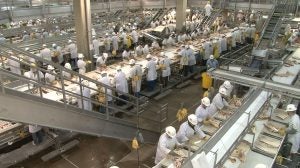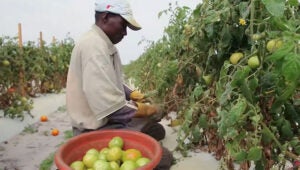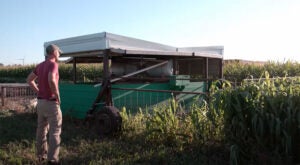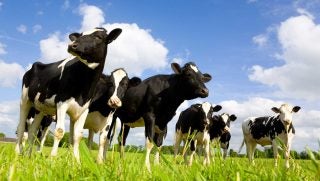More than 15 years after Robert Kenner delivered the documentary Food, Inc., which took hard stances against corporate influence in the American food system and how modern agriculture functions, a follow-up was released on streaming services this month. This Food, Inc. 2 review explores how the filmmakers view today’s food production system, where its faults and strengths are, and what are some key discussion points worth revisiting.
While the original film redefined a genre of food and farm documentary filmmaking, Food, Inc. 2 lacks much of the punch of its predecessor. That means it’ll not likely be as noteworthy (or as divisive) with viewers, despite some attempts at grandstanding — co-producer and author Michael Pollan waits no more than 90 seconds into the film to push for buying organic, grass-fed, GMO-free food.
While he might miss the scientific consensus on that point, he is correct to note, “When the pandemic hit, the curtain was peeled back, and you began to see that this highly efficient, consolidated food system is a very brittle system.”
That is intended to be the central thread in Food, Inc. 2, though it becomes easy to forget that as the film scurries a haphazard and sometimes incoherent path across food innovation, farm labor, corporate processing and marketing, Capitol Hill lobbying, and family farm consolidation.
While almost nothing that’s in Food, Inc. 2 hasn’t already been said in the pages of agricultural and mainstream news outlets, it does work to bring its perspective on the American food system to wider audiences in a more approachable — or let’s say, more processed and snackable — way.
And it does so for better or for worse, though anyone who’s seen the original Food, Inc., knows that it primarily likes to focus on the “for worse.”
AGDAILY rented Food, Inc. 2 from Amazon Prime just a couple of days after its release. Here are five major takeaways from watching the 1-hour, 34-minute documentary:
1. Tyson’s handling of the pandemic was atrocious
When people talk about agricultural consolidation, the meat-packing industry, with heavy hitters like JBS and National Beef, quickly come to mind. As does Tyson Foods.
Food, Inc. 2 talks with Tony Thompson, the sheriff of Black Hawk County, Iowa, where Waterloo is the county seat. The area is home to a major Tyson meat-packing plant, where coronavirus ran rampant in 2020. Thompson said there were 1,300 positive COVID tests among the Tyson plant’s 2,500 workers, which ultimately spread in deadly ways into the community at large.
This Tyson plant, which is the company’s largest in the U.S., had a very messy track record during the pandemic, and it’s no surprise that it was chosen as an anchor point of “big bads” in the film. A lawsuit was even filed against Tyson alleging that its plant leadership was placing bets on how many employees would contract COVID. Ultimately seven managers were fired because of those accusations.

Tyson employees were allowed to continue working there during the early months of the pandemic because of an Executive Order that deemed meat processors as “essential employees.” Still, Thompson remained skeptical about whether American food security or corporate profits were the motive, saying much of the meat from that plant gets shipped overseas. He called the revenue made during that time “blood money.”
Fast Food Nation author and Food, Inc. 2 co-producer Eric Schlosser used this as a launching point to talk about the need to break up massive industry consolidation, which happens in the beef processing industry, as well as the soda and baby formula markets.
It’s likely that audiences will embrace Schlosser’s viewpoint that “breaking up monopolies is directly linked to creating innovation.”
2. Agriculture needs to revisit farmworker treatment
Early on, Food, Inc. 2 shows immigrant farm laborers (mostly Latinos and Haitians) working the rows on Florida operations. One worker who is interviewed talks about the low pay and the difficult conditions — and, essentially, feeling disposable in his job. The film then asks a valid question: How can agriculture exploit workers like these, especially ones who help harvest fresh produce, which are among the healthiest foods we as a society can buy?
Depending on the source, immigrant labor makes up anywhere from half to 73 percent of the agricultural workforce, where they have a vital role in many crops that have to be hand-picked, such as strawberries, lettuce, apples, and tomatoes. During the pandemic, more than 2 million farmworkers were deemed “essential,” yet wage data showed that farmworkers earned just $14.62 per hour on average in 2020, far less than even some of the lowest-paid workers in the U.S. labor force.

Food, Inc. 2 correctly highlights why this is a problem for the long-term sustainability of the food system. However, the film and its production team also fail to look in on itself, which can make them come across as hypocritical.
The original Food, Inc., as well as Pollan’s 2006 book, The Omnivore’s Dilemma, were significant contributors in catapulting “lunatic farmer” Joel Salatin of Virginia into the spotlight. It has since come out that Salatin has been able to run his operation significantly on unpaid- or low-paid intern labor and has even said that interns should pay him for the privilege of working at his Polyface Farm.
While Salatin has become a severely controversial figure because of allegations of racism and his dismissive attitude toward COVID-19, Food, Inc. 2 would have done well to address his labor practices to appear more reliable in its advocacy of farm workers.
3. It’s no surprise that Sen. Booker makes an appearance
U.S. Sen. Cory Booker of New Jersey often tries to paint himself as an ally of agriculture, though the avowed vegan is really an ally of only one specific kind of agriculture.
The film meets with Booker during a media event on a Somerset County farm, where Booker talks about his enthusiasm for being on the Senate Committee on Agriculture, Nutrition, and Forestry. Early on, he calls the American food system “savagely broken,” and we certainly agree with him that it’s disheartening to know that Twinkies are cheaper to buy than apples. Access to healthy food, especially in poorer communities and other “food deserts” is a real issue.

Common ground with Booker ended there, though. Booker has long been a vocal opponent of concentrated animal feeding operations (CAFOs), and he has pushed legislation to ban them and has steered heavily into terminology such as “factory farming,” which doesn’t have any actual definition and is only used by activist factions.
He has also shown biases against genetic engineering, which has allowed fewer insecticides to be sprayed on many crops and has fueled a rise in no-till agricultural practices, both of which would be seen as positives environmentally. They’ve also shown to help improve food security when customers aren’t pressured to be afraid of them. Yet because GE crops are most likely to be commodity crops, Booker speaks out against them in the film and any subsidies that they bring with them.
“I don’t want my tax dollars subsidizing the things that are making people sick,” Booker says later in the documentary. “And now we have to pay for the health care costs of the chronic disease that we are fueling with our food system.”
Well, he had me in the first half, I’m not gonna lie …
4. Yale’s psychiatric researcher was the best part of the film
A major part of Food, Inc. 2 focused on Dana Small, a professor of psychiatry at Yale University. She was doing research funded by PepsiCo on how sweetness levels would match up with calories — including what kinds of foods our brains were most attracted to and how our bodies metabolized those foods.
Her research is delightfully engaging and left me wanting to learn so much more.
Unfortunately, she then talks about the fate or her research after PepsiCo didn’t get the findings it wanted. Pollan analyzed the situation to say that people are losing their taste for “real” food, which presumably he means whole or less-processed food.

In connection with Small’s research, Food, Inc. 2 adeptly delves into the impact ultra-processed foods have had on society, the way our minds are “tricked” into consuming more calories than we need and why the marketing departments of large food companies should have guilty consciences. It made for a fascinating exploration of how food processing has changed, and it definitely reinforced the documentary’s central tenet that food corporations are aggressively revenue-driven.
While there was a lot to agree with there, the film embraced a fixation on ingredient lists, something that Pollan has long advocated about. But it’s hard not to conjure up author and graphic designer James Kennedy’s famous ingredient lists of an all-natural banana or an all-natural egg to see just how ridiculous it can be to obsess about the number of ingredients alone in a food item.
5. The one with Impossible Foods’ founder
It was stunning to see Pollan — an anti-GMO, plant-centric, whole-food, minimal-ingredient advocate — rubbing elbows so cordially with Impossible Foods founder and former CEO Pat Brown. Brown readily spoke to Food, Inc. 2 about how he uses genetic engineering in Impossible’s recipes, and the film admits that Impossible’s meat alternatives are egregiously ultra-processed, a modern food trait that the film spent considerable time lambasting.
“They may solve one problem and create another,” Pollan said after it was noted that Impossible is in Burger King locations nationwide (so it’s both ultra-processed and part of the fast-food machine).
Pollan suggests that the “problem” Impossible Foods is solving is cattle, which he blames for being the single-worst food source for the planet’s climate.

He admits that plant-based doesn’t automatically mean healthy, while going on to say that a third of global warming is caused by agriculture, second only to transportation.
It’s unclear where he got that info from, as the U.S. Environmental Protection Agency says global agriculture contributes to 22 percent of emissions, behind both electricity and industry; while agriculture in the U.S. accounts for just 10 percent of total emissions, behind energy, industry, transportation, and residential/commercial. Plus, the EPA released data in April 2024 showing that agriculture is reducing emissions better than any other U.S. industry and is at its lowest level in 10 years.
In conclusion
These five takeaways just scratch the surface of what’s in the Food, Inc. 2 documentary, but especially for farmers and others in the food system, these points are worth fleshing out with more vigor.
Our food system would unquestionably benefit from reform. If nothing else, what films like this (as well as the original Food, Inc., Food Evolution, Before the Plate, and Farmland) do is energize people to show more interest in where their food comes from.
Ryan Tipps is the founder and managing editor of AGDAILY. He has covered farming since 2011, and his writing has been honored by state- and national-level agricultural organizations.



